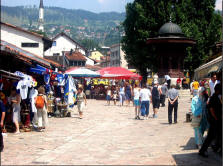|
Country Information


 |
Population
In
1991 Bosnia was home to 4,365,000 people (twice as many as live in West
Virginia; 1/3 fewer than Switzerland); its largest city was Sarajevo
(pop. 526,000). Much of Bosnia's population is urban and (until April
1992) was employed in manufacturing, mining, technology and service
industries. It is (or was) a modern, industrialized European country
with respectable educational and health-care statistics. Almost all (over
95%) of the people speak the same language (called Bosnian or
Serbo-Croatian), and come of the same European racial stock, descended
from Slavic tribes that settled in the area in the early Middle Ages.
The people of Bosnia are traditionally called Bosnians. For reasons
having to do with recent history (and as much with 20th-century
ideologies as with traditional religious allegiances), Bosnians whose
ancestors were of the Catholic faith are now identified as Bosnian
Croats (17%), while those of Eastern Orthodox background are now
identified as Bosnian Serbs (31%). The largest group of the Bosnian
population, however, are the Muslim Slavs (44% in the 1991 census),
descendants of Christian Bosnians who accepted Islam some 500 years ago.
Until the late 19th century, people of all three faiths identified
themselves simply as Bosnians. Most Bosnians today are in fact highly
secularized, and more than a third of all marriages in Bosnia since the
1950s have been between partners from different religious/ethnic
backgrounds. While there were some villages in the countryside where one
group or the other predominated, Bosnia's towns and cities have
traditionally been the shared home of people from all ethnic and
religious groups. The latter include Jews, who found a haven in the
tolerant city of Sarajevo in 1492, following their expulsion from Spain.
Unlike Jews in Venice and elsewhere in Europe, Sarajevo's Jews were not
confined to a ghetto. The city's principal mosques, its synagogues and
Christian churches are all located in close proximity to each other, a
visible sign of the intermingled public and private lives of its ethnic
and religious communities.
|
 |